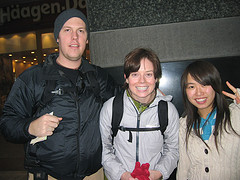Finally, the review you’ve been waiting for: apparel. Flexibility is the key. That means thinking in terms of layers and multiple use. Imagine your most extreme temperatures and activities, and pack for those. Hopefully, you just need a few more neutral items to fill in the spectrum gap. One-time use makes for unnecessary extra weight. Also keep in mind, many tour groups and local shops often rent the more specialized gear (like rain parkas and rain pants) for your more specific adventures (like overnight hiking tours), which is probably a better investment and use of packing space.
Delights:
Sunglasses – This is a no brainer, but delightful nonetheless. The polarized sunglasses Erin purchased us from REI were great, and only about $25.
Down sweater – this lightweight, flexible jacket is expensive, but worth every penny. They provide valuable insulation without the bulk on your body or in your bag. It’s amazing to see them wad up into a package smaller than a shoe. Erin went for the Patagonia version (down); I trekked in the Mountain Hardwear style (synthetic). Note, synthetic supposedly dries faster than down, and they both seemed to keep us warm well. Erin’s jacket lost many a feather – it was comical, really.
Surprisingly useless:
Waterproof jacket – My “waterproof” jacket from Patagonia was anything but. It keeps the first few minutes of rain off you, but leaks right through when you need it most. I guess breathable and water proof don’t go hand-in-hand. Worked better as a windbreaker for those breezy, chilly nights. A light jacket is essential.
Wicking T-shirts – I purchased some warm-weather sweat-wicking T-shirts knowing we were going to one of the hottest areas of the planet. I sweat easily. So I wanted some shirts that would be quick-drying and cool. Instead, these shirts not only looked bad, but performed poorly. Instead, invest in better quick-drying pants – with zipper pockets of course, for added security against evil-doer pick-pocket types.
Surprisingly useful:
Sun hat – I had heard, but I really had no idea how strong the sun really is in New Zealand and Australia. This simple Auckland acquisition from Kathmandu saved my neck, literally. Lightweight and flexible, it went from pocket to head to bag and back. I ended up wearing it daily until our last week in Sydney, when I upgraded to an Aussie reed sun hat. Very nice indeed. Note: baseball caps won’t get it done – you need the full surround brim or you’ll pay.
Other items of note:
Socks – Don’t invest in extra nice socks. For some reason, the better quality socks consistently disappeared in our laundry batches throughout China. Instead, they’d be switched with standard socks. Sneaky. Another trick I’ll try next time – bring extra loud, they-can-only-be-yours style socks. That way you can see them walk out the door. In the end, standard wool hiking socks worked great in cold weather; cotton was fine in warmer.
Digital watch with alarm – Time isn’t always that easy to come by, and wake-up calls aren’t common.
Shoes – your standard shoes are one item you’ll likely wear everyday, so you’d better love them. And they better perform in a variety of terrains. We purchased Vasque from REI, and they held up pretty well. They are water resistant, but not water proof as the Tongariro proved. (Not sure anything would have withstood the Tongariro incident.) I also really like our Chaco sandals – surprisingly, they worked well for both hiking hills and walking the beach.
References for gear purchases:
Froogle – brand name stuff at pretty good discounts.
eBay – set up your auto searches well in advance of your trip, and you may get lucky.
Outside Magazine – good source for gear reviews and new technology.
REI – what a great store.





Leave a comment